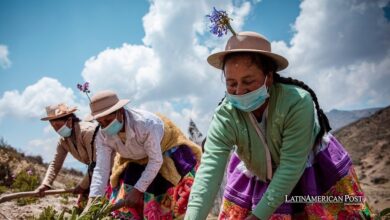Heat Stress: the New Labor Challenge Posed by Climate Change
Working in a hotter world is causing multiple challenges to ensure employee dignity and productivity. Several countries are already adapting their regulations to respond to the extreme situations generated by climate change.

Photo: Freepik
LatinAmerican Post | María Fernanda Ramírez Ramos
Escucha este artículo
Leer en español: Estrés térmico: el nuevo desafío laboral que plantea el cambio climático
"With this heat, it is impossible to work or go outside!" If you have experienced a heat wave, where temperatures exceed 38 degrees, you know what these phrases refer to. Very high temperatures make it difficult to perform various tasks, especially in environments that are not adequately ventilated, air-conditioned, or shaded. However, this is the reality that millions of workers have already experienced and that will continue to occur due to climate change.
In fact, there are those who have already cost their lives working under extreme conditions. This exposure to high temperatures is known as heat stress and is increasingly a relevant issue for labor law regulators.
What is heat stress?
The International Labor Organization, ILO, defines heat stress as: "excess heat received by the body above the levels it can tolerate without impairing its physiological capacities. Heat stress affects, above all, workers outdoors, including those working in agriculture and construction, is a very serious problem for a large proportion of the 1 billion agricultural workers and 66 million garment workers (many of whom have to work in factories and workshops without air conditioning)". Likewise, it points out that it is also a problem for those who work in the areas of transportation, waste collection, emergencies, sports, or tourism. One of the most notorious cases was that of the World Cup in Qatar, in which workers in the construction of the stadiums died, some of them due to the high temperatures.
This happens because temperatures above 39 degrees Celsius can be deadly for a person. Although they are not fatal, they can nullify or reduce the capacities of people and make their functions unbearable. "Older workers have lower physiological resistance to very high temperatures, but they represent an increasing proportion of workers, which is a natural consequence of the aging of the population. In addition, heat stress may be one of the many factors that induce the population to emigrate," says an ILO report called "Working on a hotter planet. On the other hand, the United Nations indicates that thermal stress can increase the risk of presenting occupational diseases.
We suggest you read: Climate Change and Disease: A Dangerous Combination
What is the situation of thermal stress in Latin America?
According to the aforementioned ILO report on thermal stress at work, "in the case of Latin America and the Caribbean, in the last 40 years there has been an increase in temperature of between 0.7 °C and 1 °C C throughout Central and South America. The only exception is the Chilean coast, which experienced a cooling of about 1°C during that same period." According to the IPCC, it is estimated that temperatures will increase between 1.6 °C and 6.7 °C in the region by the end of the century.
Therefore, the work of all sectors must be adapted, especially the services, construction and agriculture sectors, so that it is a decent job, free of thermal stress and risk for workers. However, the region faces great challenges, since currently not all people have decent work guarantees. In fact, "the incidence of informality in Latin America and the Caribbean is one of the highest in the world," according to the ILO.
The forecasts of this organization indicate that by 2030, 0.6 percent of total working hours will be lost due to thermal stress, which is equivalent to approximately 2.9 million full-time jobs. Likewise, this is expected to have a significant impact on GDP. According to the ILO, the 10 most affected countries in Latin America will be Guyana, Belize, Suriname, Saint Vincent and the Grenadines, Venezuela, Trinidad and Tobago, Ecuador, Panama, El Salvador, and Honduras.
What are organizations and states coming up with to manage heat stress?
On May 10, an ILO world conference was held to exchange experiences regarding heat stress management in different regions of the world. The reduction in working hours, the provision of special equipment or the prohibition of certain jobs at certain hours of the day are some of the measures that are proposed.
There are already several countries that are modifying their labor regulations to ensure the safety of workers. One of the most recent news occurred last week in Spain, where a law decree was approved that modifies the safety and health regulations at work. This includes the prohibition of certain activities during the hottest hours and the obligation of employers to provide protection to workers. According to Newtral, last year there were more than 800 deaths attributed to a heat wave.
In Cyprus, there are regulations on the maximum temperatures to which a worker can be subjected. In Algeria, the coverage of the National Unemployment Insurance Fund for the Construction, Public Works and Hydraulics Sectors contemplates work stoppages in relation to the weather. Germany and Romania have standards to provide guarantees to employees in the case of very low temperatures.
Regarding international standards, the International Labor Organization already has various conventions, regulations, and recommendations for States to effectively address the challenges posed by heat stress for labor rights and decent work. However, it is also the role of governments to accelerate the implementation of regulations and guarantees for those who work in environments vulnerable to extreme heat. Likewise, it is essential that they invest in infrastructure in the cities that allows mitigating extreme heat.




